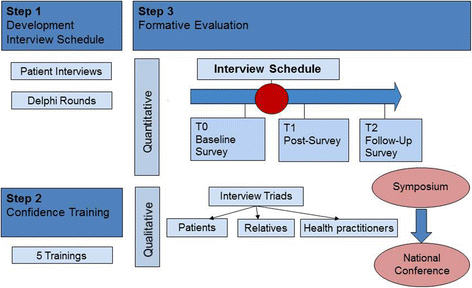The DEsire to DIe in Palliative care: Optimization of Management (DEDIPOM) - a study protocol
- PMID: 29458344
- PMCID: PMC5819295
- DOI: 10.1186/s12904-018-0279-3
The DEsire to DIe in Palliative care: Optimization of Management (DEDIPOM) - a study protocol
Abstract
Background: A desire to die (DD) is frequent in palliative care (PC). However, uncertainty remains as to the appropriate therapeutic response. (Proactive) discussion of DD is not usually part of standard care. To support health practitioners' (HPs) reactions to a patient's DD, a training program has been developed, piloted and evaluated. Within this framework, a first draft of a semi-structured clinical interview schedule with prompts (CISP) has been developed, including recommendations for action to support HPs' self-confidence. The aim of this study is the further development of the CISP to support routine exploration of death and dying distress and proactive addressing of a DD.
Methods: This observatory, prospective health services study comprises a three step study design: 1. Revision of the CISP and consensus finding based on semi-structured interviews with patients and a Delphi process with (inter-)national experts, patient representatives and relatives; 2. Increasing confidence in HPs through a 2 day-training program using the consented CISP; 3. A formative quantitative evaluation of conversations between HPs and patients (300 palliative patients at three time points) and a qualitative evaluation based on interview triads of patients, relatives and HPs. The evaluation of conversations will include patient-oriented outcomes, including perceived relationships with HPs and death and dying distress. We will also consider aspects of social inequality and gender.
Discussion: The intervention can provide a framework for open discussion of DD and a basis for enhancing a trustful HP-patient relationship in which such difficult topics can be addressed. The benefits of this study will include (a) the creation of the first consented semi-structured approach to identify and address DD and to respond therapeutically, (b) the multi-professional enhancement of confidence in dealing with patients' DD and an intervention that can flexibly be integrated into other training and education programs and (c) an evaluation of effects of this intervention on patients, relatives and HPs, with attention to social inequality and gender.
Trial registration: The study is registered in the German Clinical Trials Register ( DRKS00012988 ; registration date: 27.9.2017) and in the Health Services Research Database ( VfD_DEDIPOM_17_003889 ; registration date: 14.9.2017).
Keywords: Assisted dying; Communication; Desire to die; General and specialized palliative care; Multi-professional; Relationship; Suicidal ideation; Suicide; Training; Wish towards hastening death.
Conflict of interest statement
Ethics approval and consent to participate
Ethical approval for this study was obtained from the Ethics Committee of the University of Cologne (#17–265; 4th September 2017). All study information and patient consent forms are approved by the Ethics committee.
Consent for publication
Not applicable.
Competing interests
The authors declare that they have no competing interests.
Publisher’s Note
Springer Nature remains neutral with regard to jurisdictional claims in published maps and institutional affiliations.
Figures
Similar articles
-
The desire to die in palliative care: a sequential mixed methods study to develop a semi-structured clinical approach.BMC Palliat Care. 2020 Apr 16;19(1):49. doi: 10.1186/s12904-020-00548-7. BMC Palliat Care. 2020. PMID: 32299415 Free PMC article.
-
Sexual Harassment and Prevention Training.2024 Mar 29. In: StatPearls [Internet]. Treasure Island (FL): StatPearls Publishing; 2025 Jan–. 2024 Mar 29. In: StatPearls [Internet]. Treasure Island (FL): StatPearls Publishing; 2025 Jan–. PMID: 36508513 Free Books & Documents.
-
[Volume and health outcomes: evidence from systematic reviews and from evaluation of Italian hospital data].Epidemiol Prev. 2013 Mar-Jun;37(2-3 Suppl 2):1-100. Epidemiol Prev. 2013. PMID: 23851286 Italian.
-
Health professionals' experience of teamwork education in acute hospital settings: a systematic review of qualitative literature.JBI Database System Rev Implement Rep. 2016 Apr;14(4):96-137. doi: 10.11124/JBISRIR-2016-1843. JBI Database System Rev Implement Rep. 2016. PMID: 27532314
-
Factors that impact on the use of mechanical ventilation weaning protocols in critically ill adults and children: a qualitative evidence-synthesis.Cochrane Database Syst Rev. 2016 Oct 4;10(10):CD011812. doi: 10.1002/14651858.CD011812.pub2. Cochrane Database Syst Rev. 2016. PMID: 27699783 Free PMC article.
Cited by
-
"Withstanding ambivalence is of particular importance"-Controversies among experts on dealing with desire to die in palliative care.PLoS One. 2021 Sep 24;16(9):e0257382. doi: 10.1371/journal.pone.0257382. eCollection 2021. PLoS One. 2021. PMID: 34559828 Free PMC article.
-
The desire to die in palliative care: a sequential mixed methods study to develop a semi-structured clinical approach.BMC Palliat Care. 2020 Apr 16;19(1):49. doi: 10.1186/s12904-020-00548-7. BMC Palliat Care. 2020. PMID: 32299415 Free PMC article.
-
Understanding why patients request euthanasia when it is illegal: a qualitative study in palliative care units on the personal and practical impact of euthanasia requests.Palliat Care Soc Pract. 2022 Jan 10;16:26323524211066925. doi: 10.1177/26323524211066925. eCollection 2022. Palliat Care Soc Pract. 2022. PMID: 35036915 Free PMC article.
-
Medical Assistance in Dying in patients with advanced cancer and their caregivers: a mixed methods longitudinal study protocol.BMC Palliat Care. 2021 Jul 21;20(1):117. doi: 10.1186/s12904-021-00793-4. BMC Palliat Care. 2021. PMID: 34289838 Free PMC article.
-
The double awareness of the wish to hasten death and the will to live: A secondary analysis of outlier patients from a mixed-methods study.Palliat Med. 2024 Oct;38(9):1042-1053. doi: 10.1177/02692163241269689. Epub 2024 Aug 16. Palliat Med. 2024. PMID: 39152645 Free PMC article.
References
-
- Kelly B, Burnett P, Pelusi D, Badger S, Varghese F, Robertson M. Factors associated with the wish to hasten death: a study of patients with terminal illness. Psycholical Med. 2003;33:75–81. - PubMed
Publication types
MeSH terms
Grants and funding
LinkOut - more resources
Full Text Sources
Other Literature Sources
Medical
Research Materials
Miscellaneous




